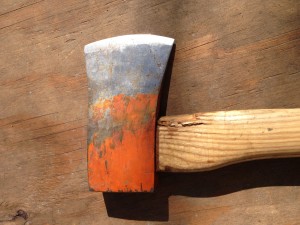 So, you’ve come up with an old axe head, or your current axe has a damaged handle, and you want to get it back into serviceable condition. Here are the steps involved in taking this project on. (Figure 1)
So, you’ve come up with an old axe head, or your current axe has a damaged handle, and you want to get it back into serviceable condition. Here are the steps involved in taking this project on. (Figure 1)
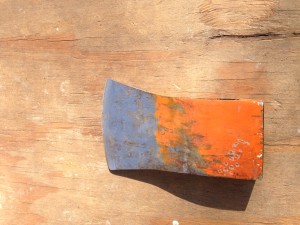 The very first step is finding a haft of the proper length and a wedge of sufficient size to completely fill the eye of the axe. After you have an acceptable piece of wood, the tools you will need to complete the task are as follows: A wood rasp (a four in hand works great for this), a mallet of some type, a hand saw, and some boiled linseed oil (hereafter referred to as BLO).
The very first step is finding a haft of the proper length and a wedge of sufficient size to completely fill the eye of the axe. After you have an acceptable piece of wood, the tools you will need to complete the task are as follows: A wood rasp (a four in hand works great for this), a mallet of some type, a hand saw, and some boiled linseed oil (hereafter referred to as BLO).
If the head has any wood in the eye, or if the handle is still on, you’ll have to remove this. (Figure 2) Now is when you want to do any work to the head such as rust or paint removal, and any edge or poll dressing. After working the edge, take some masking tape and cover the edge to protect you from it.
The eye of an axe head is slightly larger at the top than it is at the bottom. This is to allow the wood to swell and not allow the head to come off.
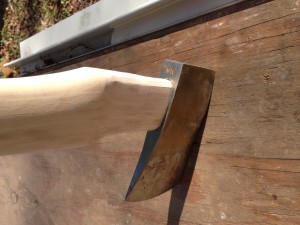 Now take the haft and see how the shape matches the eye to get an idea where to start removing wood to get it to start into the head. (Figure 3) Once it will start, you can use the friction marks left on the wood to see where more needs removed.
Now take the haft and see how the shape matches the eye to get an idea where to start removing wood to get it to start into the head. (Figure 3) Once it will start, you can use the friction marks left on the wood to see where more needs removed.
 (Figure 4) To drive the head onto the haft once it will start, grab the handle by the end upside down, and smack the up end of the haft with the mallet till the head will not seat any farther. Then place the head across the open jaws of a vice or some other like item and use a wooden dowel of some sort to drive the haft back out of the head. You can tell where the head stopped and where wood needs removed. Repeat this step until the head seats squarely on the shoulder of the haft with the excess wood sticking out of the head. I like to have at least 1/4” of the haft sticking out of the eye, so when the wedge is driven in, it swells the haft out and creates a rivet effect that helps to secure the head.(Figure 5) Most times I will have more than 1/4” sticking out and will have to trim it. This will be done after the wedge is set.
(Figure 4) To drive the head onto the haft once it will start, grab the handle by the end upside down, and smack the up end of the haft with the mallet till the head will not seat any farther. Then place the head across the open jaws of a vice or some other like item and use a wooden dowel of some sort to drive the haft back out of the head. You can tell where the head stopped and where wood needs removed. Repeat this step until the head seats squarely on the shoulder of the haft with the excess wood sticking out of the head. I like to have at least 1/4” of the haft sticking out of the eye, so when the wedge is driven in, it swells the haft out and creates a rivet effect that helps to secure the head.(Figure 5) Most times I will have more than 1/4” sticking out and will have to trim it. This will be done after the wedge is set.
 After getting the head seated, take it back off one last time and check the slot for the wedge. It needs to go down at least two thirds of the way into the head. If it don’t, take the hand saw and cut the kerf deeper.
After getting the head seated, take it back off one last time and check the slot for the wedge. It needs to go down at least two thirds of the way into the head. If it don’t, take the hand saw and cut the kerf deeper.
While the head is off for the last time is when you want to do any final sanding or dressing on the haft.
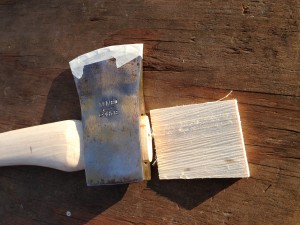 Now you can drive the head on and proceed to set the wedge. Make sure the wedge you want to use will fill the eye front to back. If it is too wide, trim it to fit the eye.(Figure 6 & 7) Once it is ready to drive in, coat the wedge in BLO to lube it. Once it is started, use a block of wood between the mallet and the wedge, so when you drive it in, the force of the blows will be evenly distributed across the whole wedge. Once the wedge is seated as far as it will go, trim it flush with the haft. I have found, along with others, that when leaving the haft stick out, or proud, that the metal wedges are not needed to secure the haft.
Now you can drive the head on and proceed to set the wedge. Make sure the wedge you want to use will fill the eye front to back. If it is too wide, trim it to fit the eye.(Figure 6 & 7) Once it is ready to drive in, coat the wedge in BLO to lube it. Once it is started, use a block of wood between the mallet and the wedge, so when you drive it in, the force of the blows will be evenly distributed across the whole wedge. Once the wedge is seated as far as it will go, trim it flush with the haft. I have found, along with others, that when leaving the haft stick out, or proud, that the metal wedges are not needed to secure the haft.
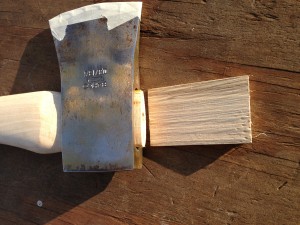 The next step is to find a container that the axe head will fit into for the BLO soak. I like to soak the axe in BLO for a week minimum. The reason for this is to swell the wood and therefore making the head even more secure.
The next step is to find a container that the axe head will fit into for the BLO soak. I like to soak the axe in BLO for a week minimum. The reason for this is to swell the wood and therefore making the head even more secure.
The final step I do is to soak the haft in a piece of PVC pipe standing upright and filled with BLO for a week minimum. This really soaks in and protects the haft, and brings out the character in the wood. (Fig 8)
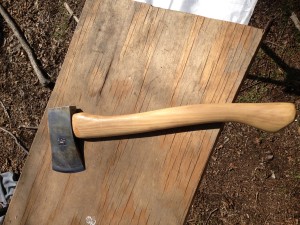 If you take on a project like this, Beware, it is addictive. You will be hitting all the local shops for old heads to revive and put back into service.
If you take on a project like this, Beware, it is addictive. You will be hitting all the local shops for old heads to revive and put back into service.
I hope you’ve enjoyed this article and if you want to chat, just reply below!
– Dale L. Spaht Jr. is a member of BCUSA, will be attending Woodsmoke 2013, and resides in the southeastern woods of Kansas where he spends his rarely spare time restoring axes and designing great patches for all your outdoor accessories via Dale’s Patches!
Wanna Get instant updates for Master Woodsman? Subscribe on Twitter and like us on Facebook below.


2 Responses to How To Haft An Axe by Dale L. Spaht Jr.